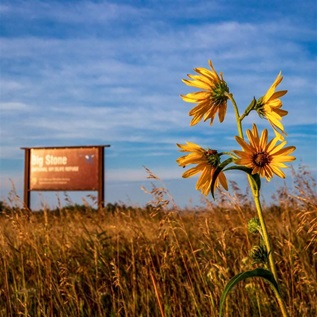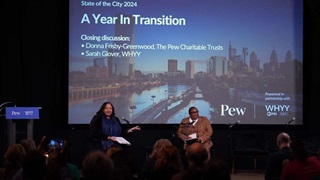Coastal Wetlands Take Center Stage at 2023 Ocean and Climate Change Dialogue
A growing number of countries and initiatives are recognizing mangrove, seagrass, and saltmarsh ecosystems as viable nature-based solutions

With the effects of climate change manifesting around the world daily—and scientists projecting worse outcomes in the future—it is increasingly urgent that policymakers take ambitious action to reduce greenhouse gas emissions and adapt to the impacts already occurring.
That reality will define discussions and debate at the 28th Conference of the Parties (COP28) to the United Nations Framework Convention on Climate Change (UNFCCC) in the United Arab Emirates this December. The COP28 agenda includes a readout of the first Global Stocktake (GST), an inventory of countries’ collective progress toward achieving the goals of the Paris Agreement. The GST, which will also identify gaps in climate progress and potential ways to address them, will be critical to framing climate ambition and action over the next five years—when reporting on the next GST is scheduled—and beyond.
This year’s report provides another opportunity to elevate the contribution that ocean-based solutions can make to climate change mitigation, adaptation, and resilience. Research, including studies using methodologies established by the U.N. Intergovernmental Panel on Climate Change, shows that protecting coastal wetlands—also known as “blue carbon” ecosystems on account of their capacity to sequester store significant amounts of carbon, mostly in their soils—can help mitigate the effects of climate change. Governments can recognize this benefit as part of their nationally determined contributions (NDCs) toward achieving Paris Agreement goals. This focus comes at a good time because countries are required to submit more ambitious NDCs by 2025. Ocean-based climate solutions are among a diverse toolkit of climate actions that parties can implement, alongside necessary emissions reductions, to meet the goals.
In recent years, governments, scientists, and civil society have recognized the role that ocean-based climate solutions can play in meeting the goals of the Paris Agreement. This includes technical solutions, such as offshore wind turbines and other renewable energy as well as the protection and restoration of coastal wetlands, including mangroves, seagrass beds, and saltmarshes, and other nature-based solutions.
Central to this growing recognition within the UNFCCC has been the establishment of the Ocean and Climate Change Dialogue, a forum for showcasing ocean-based climate solutions and assessing how best to scale and accelerate action. The dialogue requested by countries at COP25 in 2019 in Madrid, now occurs annually at the summer intersessional meetings of the UNFCCC in Bonn, Germany. After the inception of the dialogue in 2019 and a second dialogue in 2021, the growing prominence of ocean-based solutions in the fight against climate change was further consolidated at COP27 in 2022, in Sharm El-Sheikh, Egypt, where countries agreed to include them in their NDCs.
This year’s dialogue, co-chaired by Canada and Chile on June 13-14, focused on two specific themes: coastal ecosystem restoration, including blue carbon, and fisheries and food security.
Coastal wetlands have become powerful symbols of the role that marine nature-based solutions can play in addressing climate change. In addition to the measurable amount by which these blue carbon ecosystems can reduce emissions, coastal wetlands provide a range of benefits for adapting and becoming more resilient to the impacts of climate change. For example, they help stabilize shorelines, protecting frontline communities from increasingly severe weather, and they provide vital ecosystem services, such as water filtration and habitat, for fish and other wildlife. As such, commitments to protect or restore coastal wetlands within NDCs can provide a full spectrum of benefits in climate change mitigation, adaptation, and resiliency.
The June dialogue provided a space, in part by separating into small breakout groups of about 10 people each, for parties and other stakeholders to reflect and share examples of how they engage in the two themes of this year’s dialogue: coastal ecosystem restoration including blue carbon, and fisheries and food security. This format, not always seen at UNFCCC meetings, allowed for the inclusion of a broader scope of people and ideas into the discussion that relying solely on interventions from plenary format, and it stimulated conversation and led to outcomes that represent diverse perspectives and experiences relating to the many benefits of coastal ecosystems.
Key themes relating to coastal wetlands that were identified through the breakout groups included:
- The need to strengthen awareness across parties of the benefits that conservation of coastal wetlands can provide to local communities’ and economies’ awareness.
- The need to bolster and consolidate data and research efforts to inform various financing mechanisms and national policy efforts—in particular, National Greenhouse Gas Inventories.
- The strong governmental coordination required to effectively manage coastal wetlands, as they are often subject to multiple policy frameworks and overseen by numerous institutions.
- Emphasis that coastal wetlands’ blue carbon mitigation benefits should not be considered a substitute for emissions reductions across other sectors.
- The need to further include and elevate local and Indigenous communities in the design, execution, and implementation of specific site-based efforts.
Dialogue participants also shared case studies of coastal wetland action taking place in various locations, including Colombia, Indonesia, Madagascar, Senegal, the United States, and the three partner countries from the first phase of The Pew Charitable Trust’s protecting coastal wetlands and coral reefs project: Belize, Costa Rica, and Seychelles.
Ocean-based climate solutions are by no means limited to coastal wetlands or to nature-based solutions. In fact, the majority of emissions reduction potential lies in technical solutions, such as scaling the deployment of renewable energy.
However, the triple benefit that coastal wetlands can provide in helping mitigate, adapt to, and enhance resilience to the effects of climate change has become a powerful symbol of the role nature-based solutions have in addressing climate change. Numerous countries are seizing this opportunity. With the stakes so high, it’s critical that more do so at COP28—and far beyond.
Anelise Zimmer is a principal associate and Thomas Hickey is the project director with The Pew Charitable Trusts’ protecting coastal wetlands and coral reefs project.
Spotlight on Mental Health
MORE FROM PEW
Explore Pew’s new and improved
Fiscal 50 interactive
Your state's stats are more accessible than ever with our new and improved Fiscal 50 interactive:
- Maps, trends, and customizable charts
- 50-state rankings
- Analysis of what it all means
- Shareable graphics and downloadable data
- Proven fiscal policy strategies
Welcome to the new Fiscal 50
Key changes include:
- State pages that help you keep track of trends in your home state and provide national and regional context.
- Interactive indicator pages with highly customizable and shareable data visualizations.
- A Budget Threads feature that offers Pew’s read on the latest state fiscal news.













